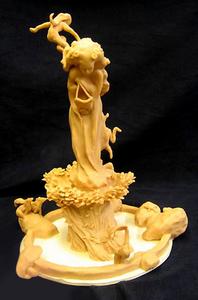

This "maquette" a three-dimensional miniature, was approved before work began.
*** Story & Photo Essay by Angela Wampler and Hank Daniel with additional photos courtesy of Barter Theatre, Charles Vess and David Spence. ***
Like setting up a chess game, the figures for a fantastical fairy fountain are being added to the entry for Barter Theatre's Stonewall Square in Abingdon, Va.
About two years ago, the artists, David Spence and Charles Vess, began the long process that is leading to the finished bronzes.
The centerpiece is a 16-foot-tall statue of Titania, the Faery Queen from Shakespeare's "Midsummer Night's Dream." At press time, her final bronze form was incomplete.
A structure of steel pipe, copper tubing and wire mesh was used to articulate her skeleton. With Plasticine, a modeling clay, she began taking shape, but not without problems.
Vess says, "We were, perhaps, a little more than a week away from completion when the faeries began to laugh at us mere mortals. I was working below the face and heard a series of small cracks. I looked up and Queen Titania slowly leaned forward, bending over as if to kiss me perhaps? But that's 300 or so pounds of clay we're talking about. A central steel pipe had snapped and down she came, to rest gently on scaffolding that I quickly swung under her form."
The clay was stripped off, and a new, and much sturdier structure of steel rebar was welded into place before the artists started over again. Vess recalls that another idea later "became both a blessing and a curse."
Spence decided rather than cut granite being used for the various boulders around the structure that they would use real boulders and make casts of those, to later be poured in bronze. Spence and an assistant covered real stones with rubber molds from which wax forms were poured. Once in the wax, the shapes were adjusted to suit the artists' needs, then cast in bronze.
In the studio, both David Spence and Charles Vess worked on the animals that will surround the faery queen, first molding their forms in clay. Vess says, "He would work on one end, while I worked on the other. When either of us ran into a dead end of 'this doesn't look quite right,' we would shift around, and a fresh eye and hand would take over. Oh, the conversations that we had...Slowly the figures would emerge from the plasticine clay."
For reference, Vess recalls, the studio was blanketed in downloaded printouts, most of them found during long sessions on Google image searches of the animals they needed. "A hare, for instance, is quite different in form than the more common bunny rabbit," Vess notes.
Puck's clay figure was cut into several sections, which were painted with many layers of rubber mold solution, from which a wax replica was poured. Any adjustments that were needed were executed in that malleable wax. The wax replica was dipped multiple times into ceramic material to form a hard mold. The wax was burned out and, later, bronze poured into the mold.
Various sections of the intended piece are welded back together. After weld marks are ground down and smoothed out, the reassembled figure is painted with layers of patina (liquid acids that produce various colors on the surface of the bronze).
THERE'S MORE ART IN PUBLIC PLACES:
-- Bristol, TN-VA: Arts Alliance Announces Winners of Sculpture Competition
-- Bristol, Va.: Art Is At The Heart of College's Campus
-- Abingdon: 'Banjo Man' Plays Solo Show at Barter's Stage II